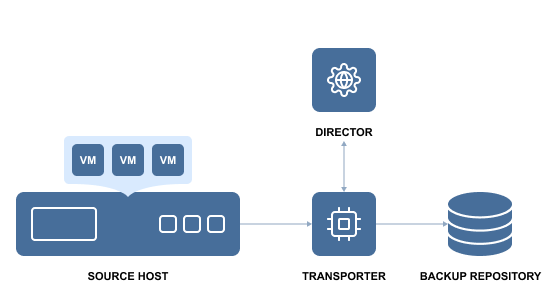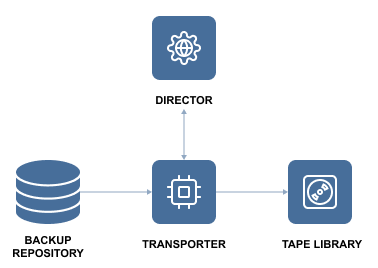Backup to Tape
NAKIVO Backup & Replication provides native tape support for automated tape libraries, including virtual tape libraries (VTL), as well as standalone tape drives.
Backup to Tape is the process of backing up critical data to a tape cartridge. In essence, backing up to tape means creating a backup, storing it in the repository and then moving it to a tape cartridge for safekeeping. NAKIVO Backup & Replication supports backups of the following platforms: VMware, Hyper-V, Nutanix AHV, Amazon Amazon EC2, and physical machines. The backups can be sent to physical tape libraries or VTL for storing. NAKIVO Backup & Replication allows for realizing the Disk Staging (D2D2T) backup strategy, where disks are used as an additional, temporary stage of the backup process before finally storing backup to tape.
In NAKIVO Backup & Replication, the process of storing backups to tape consists of two stages:
Stage 1 – creating backups and storing them in the Backup Repository:

Stage 2 – copying backups from the repository to the tape library:
Recovering from tape is the reverse of backing up: the backups stored on the tape cartridges are first recovered to the Backup Repository and then recovered using NAKIVO Backup & Replication's tools.
Before you back up/recover to/from tape (physical or VTL), you need to configure NAKIVO Backup & Replication by adding tape libraries, discovering cartridges, etc.
The Native Tape support is fully integrated into NAKIVO Backup & Replication solution and allows you to administer all backup and restore operations on tapes directly from the application's user interface. Saving data on tapes presents you with the same data managing options as disk repositories: you can store full and incremental backups, apply user-defined retention settings to the archived data, select restore points and so on.
NAKIVO Backup & Replication supports Linear Tape-Open tape libraries and standalone tape drives starting from generation 3 (LTO3) or later as well as VTL. Using the solution, you can discover not only tape libraries and standalone devices, but also the tape cartridges in those devices.
Note
All the tape cartridges discovered within a Robotic Tape Library should have barcodes for the best performance of the product. For standalone tape devices, this is not essential.
Also, any changes to the tape infrastructure (moving or removing cartridges, changing their order, etc.) made by any other means (i.e. manually or via command line) rather than with NAKIVO Backup & Replication is the user's responsibility, since the system is unaware of such changes.
NAKIVO Backup & Replication supports writing/reading backups to/from discovered tape cartridges, as well as other operations, like moving cartridges between slots, erasing, scanning, etc.
The table below provides a description of some of the tape-related terms:
|
Term |
Description |
|---|---|
|
Tape Library |
A storage device that includes one or more tape drives, a number of slots and a media changer (robot). |
|
Tape Drive |
A device component (or a standalone device) used to read and write the tape cartridge. |
|
Slot |
A place in the tape library designed to hold a single cartridge. |
|
Mail Slot |
A slot in the tape library that allows you to physically add or remove a tape cartridge without disturbing the operation of the tape library. |
|
Media Changer |
A device component used to move a single tape cartridge between slots and load/unload the cartridge to/from the tape drive. |
|
Tape Cartridge (Tape) |
A unit of sequential magnetic medium and an optional barcode used for identification. |
|
Media Pool |
A logical container that contains tape cartridges. |
|
Backup (Tape) |
A logical entity containing one or more recovery points on one or more tape cartridge(s) that belong to a single source object. |
|
Recovery Point (Tape) |
A complete or incomplete data set required to rebuild a VM or instance as of a particular moment in time. |
